sensor BMW 328I XDRIVE 2013 Owner's Manual
[x] Cancel search | Manufacturer: BMW, Model Year: 2013, Model line: 328I XDRIVE, Model: BMW 328I XDRIVE 2013Pages: 242, PDF Size: 5.38 MB
Page 133 of 242
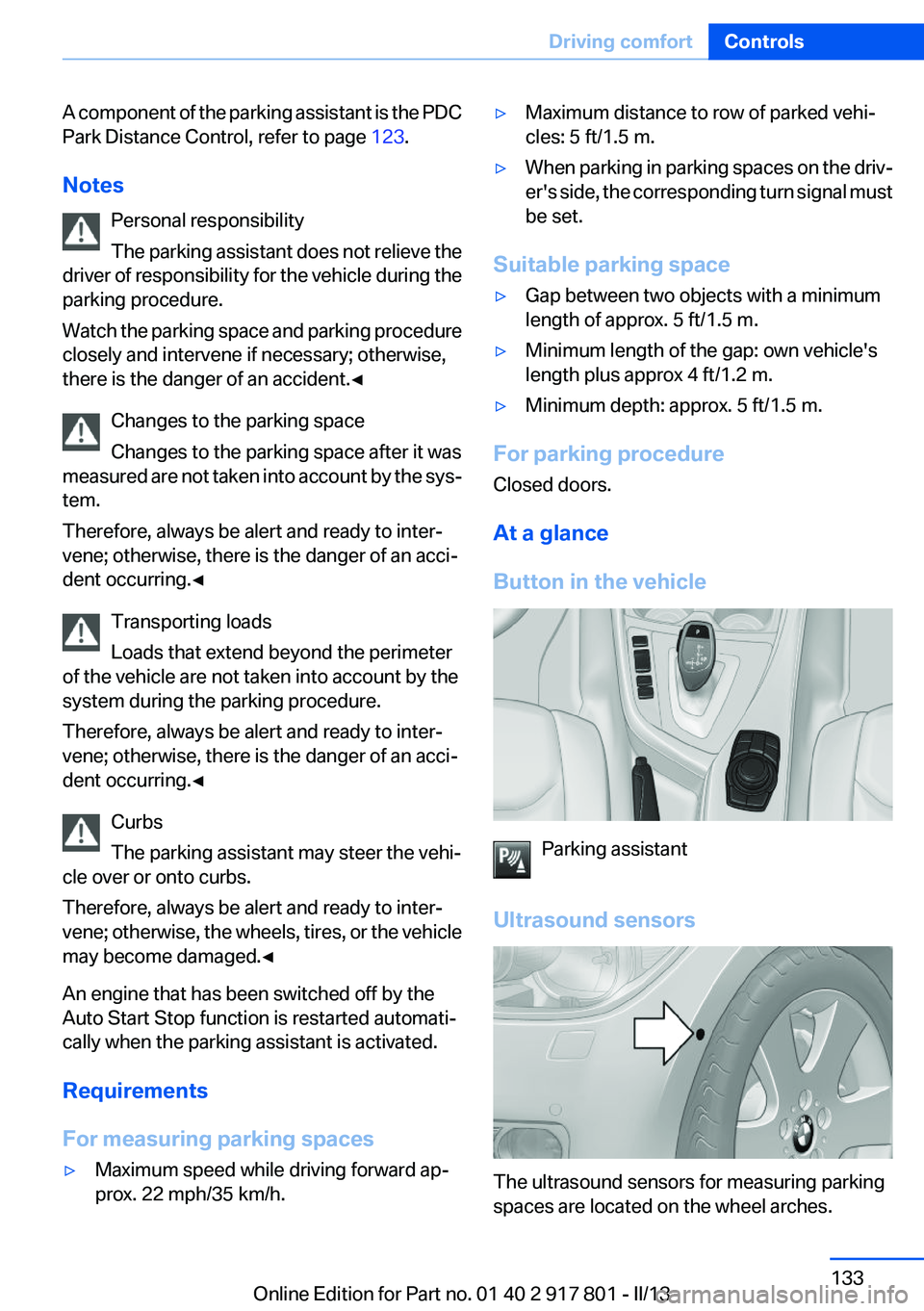
A component of the parking assistant is the PDC
Park Distance Control, refer to page 123.
Notes Personal responsibility
The parking assistant does not relieve the
driver of responsibility for the vehicle during the
parking procedure.
Watch the parking space and parking procedure
closely and intervene if necessary; otherwise,
there is the danger of an accident.‚óÄ
Changes to the parking space
Changes to the parking space after it was
measured are not taken into account by the sys‚Äź
tem.
Therefore, always be alert and ready to inter‚Äź
vene; otherwise, there is the danger of an acci‚Äź
dent occurring.‚óÄ
Transporting loads
Loads that extend beyond the perimeter
of the vehicle are not taken into account by the
system during the parking procedure.
Therefore, always be alert and ready to inter‚Äź
vene; otherwise, there is the danger of an acci‚Äź
dent occurring.‚óÄ
Curbs
The parking assistant may steer the vehi‚Äź
cle over or onto curbs.
Therefore, always be alert and ready to inter‚Äź
vene; otherwise, the wheels, tires, or the vehicle
may become damaged.‚óÄ
An engine that has been switched off by the
Auto Start Stop function is restarted automati‚Äź
cally when the parking assistant is activated.
Requirements
For measuring parking spaces‚Ė∑Maximum speed while driving forward ap‚Äź
prox. 22 mph/35 km/h.‚Ė∑Maximum distance to row of parked vehi‚Äź
cles: 5 ft/1.5 m.‚Ė∑When parking in parking spaces on the driv‚Äź
er's side, the corresponding turn signal must
be set.
Suitable parking space
‚Ė∑Gap between two objects with a minimum
length of approx. 5 ft/1.5 m.‚Ė∑Minimum length of the gap: own vehicle's
length plus approx 4 ft/1.2 m.‚Ė∑Minimum depth: approx. 5 ft/1.5 m.
For parking procedure
Closed doors.
At a glance
Button in the vehicle
Parking assistant
Ultrasound sensors
The ultrasound sensors for measuring parking
spaces are located on the wheel arches.
Seite 133Driving comfortControls133
Online Edition for Part no. 01 40 2 917 801 - II/13
Page 134 of 242
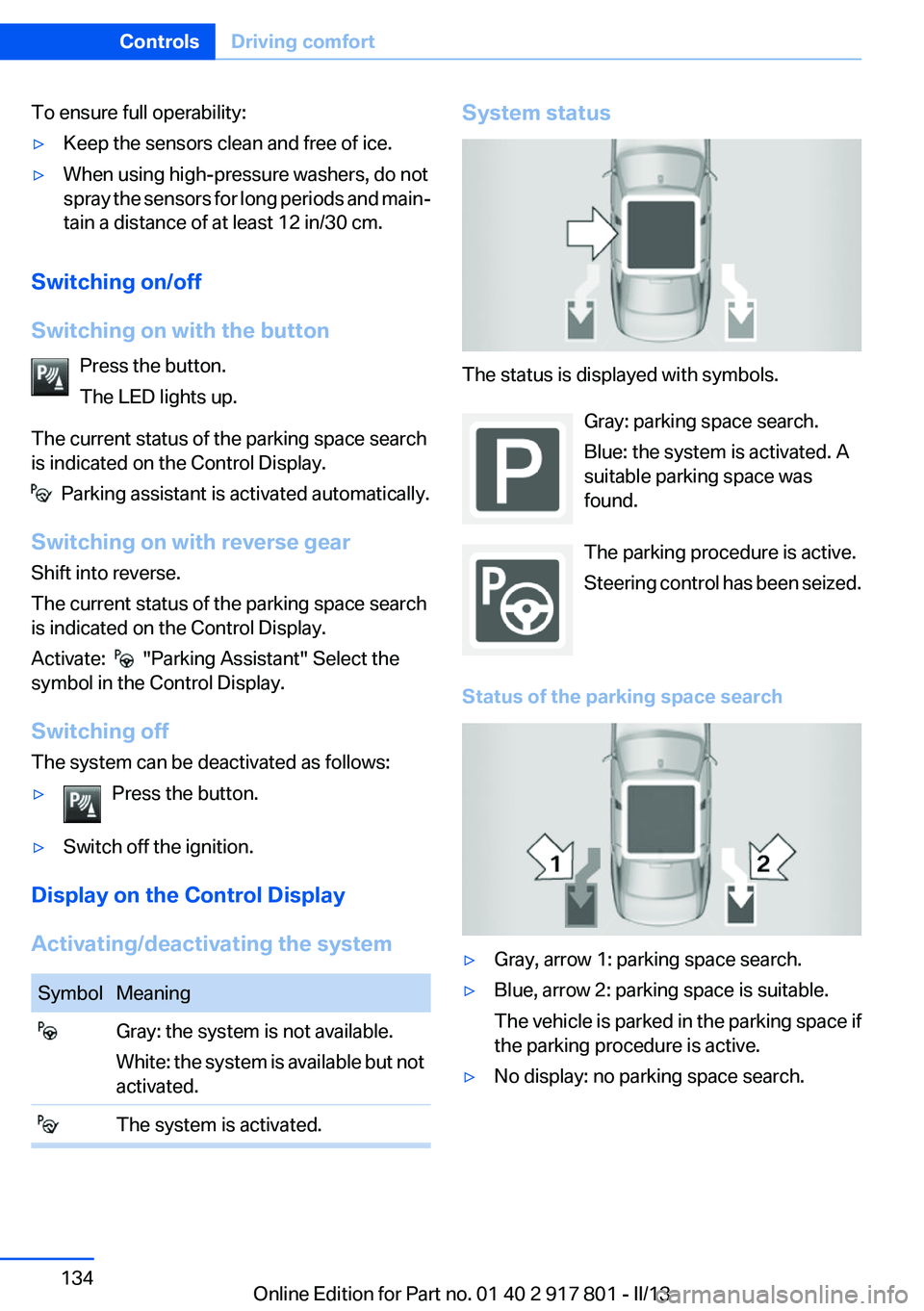
To ensure full operability:‚Ė∑Keep the sensors clean and free of ice.‚Ė∑When using high-pressure washers, do not
spray the sensors for long periods and main‚Äź
tain a distance of at least 12 in/30 cm.
Switching on/off
Switching on with the button Press the button.
The LED lights up.
The current status of the parking space search
is indicated on the Control Display.
Parking assistant is activated automatically.
Switching on with reverse gear
Shift into reverse.
The current status of the parking space search
is indicated on the Control Display.
Activate:
"Parking Assistant" Select the
symbol in the Control Display.
Switching off
The system can be deactivated as follows:
‚Ė∑Press the button.‚Ė∑Switch off the ignition.
Display on the Control Display
Activating/deactivating the system
SymbolMeaning Gray: the system is not available.
White: the system is available but not
activated. The system is activated.System status
The status is displayed with symbols.
Gray: parking space search.
Blue: the system is activated. A
suitable parking space was
found.
The parking procedure is active.
Steering control has been seized.
Status of the parking space search
‚Ė∑Gray, arrow 1: parking space search.‚Ė∑Blue, arrow 2: parking space is suitable.
The vehicle is parked in the parking space if
the parking procedure is active.‚Ė∑No display: no parking space search.Seite 134ControlsDriving comfort134
Online Edition for Part no. 01 40 2 917 801 - II/13
Page 135 of 242
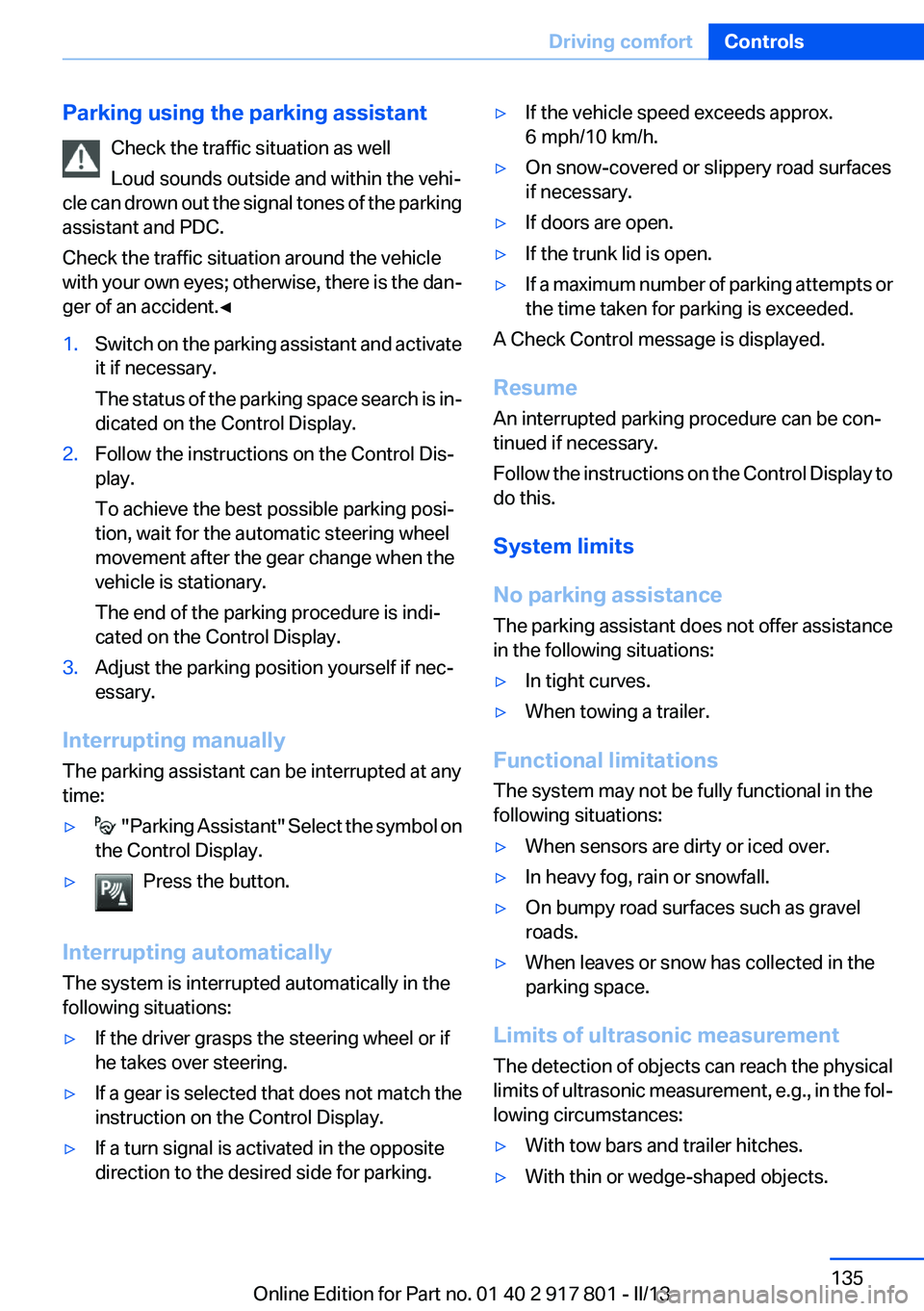
Parking using the parking assistantCheck the traffic situation as well
Loud sounds outside and within the vehi‚Äź
cle can drown out the signal tones of the parking
assistant and PDC.
Check the traffic situation around the vehicle
with your own eyes; otherwise, there is the dan‚Äź
ger of an accident.‚óÄ1.Switch on the parking assistant and activate
it if necessary.
The status of the parking space search is in‚Äź
dicated on the Control Display.2.Follow the instructions on the Control Dis‚Äź
play.
To achieve the best possible parking posi‚Äź
tion, wait for the automatic steering wheel
movement after the gear change when the
vehicle is stationary.
The end of the parking procedure is indi‚Äź
cated on the Control Display.3.Adjust the parking position yourself if nec‚Äź
essary.
Interrupting manually
The parking assistant can be interrupted at any
time:
‚Ė∑ " Parking Assistant" Select the symbol on
the Control Display.‚Ė∑Press the button.
Interrupting automatically
The system is interrupted automatically in the
following situations:
‚Ė∑If the driver grasps the steering wheel or if
he takes over steering.‚Ė∑If a gear is selected that does not match the
instruction on the Control Display.‚Ė∑If a turn signal is activated in the opposite
direction to the desired side for parking.‚Ė∑If the vehicle speed exceeds approx.
6 mph/10 km/h.‚Ė∑On snow-covered or slippery road surfaces
if necessary.‚Ė∑If doors are open.‚Ė∑If the trunk lid is open.‚Ė∑If a maximum number of parking attempts or
the time taken for parking is exceeded.
A Check Control message is displayed.
Resume
An interrupted parking procedure can be con‚Äź
tinued if necessary.
Follow the instructions on the Control Display to
do this.
System limits
No parking assistance
The parking assistant does not offer assistance
in the following situations:
‚Ė∑In tight curves.‚Ė∑When towing a trailer.
Functional limitations
The system may not be fully functional in the
following situations:
‚Ė∑When sensors are dirty or iced over.‚Ė∑In heavy fog, rain or snowfall.‚Ė∑On bumpy road surfaces such as gravel
roads.‚Ė∑When leaves or snow has collected in the
parking space.
Limits of ultrasonic measurement
The detection of objects can reach the physical
limits of ultrasonic measurement, e.g., in the fol‚Äź
lowing circumstances:
‚Ė∑With tow bars and trailer hitches.‚Ė∑With thin or wedge-shaped objects.Seite 135Driving comfortControls135
Online Edition for Part no. 01 40 2 917 801 - II/13
Page 136 of 242
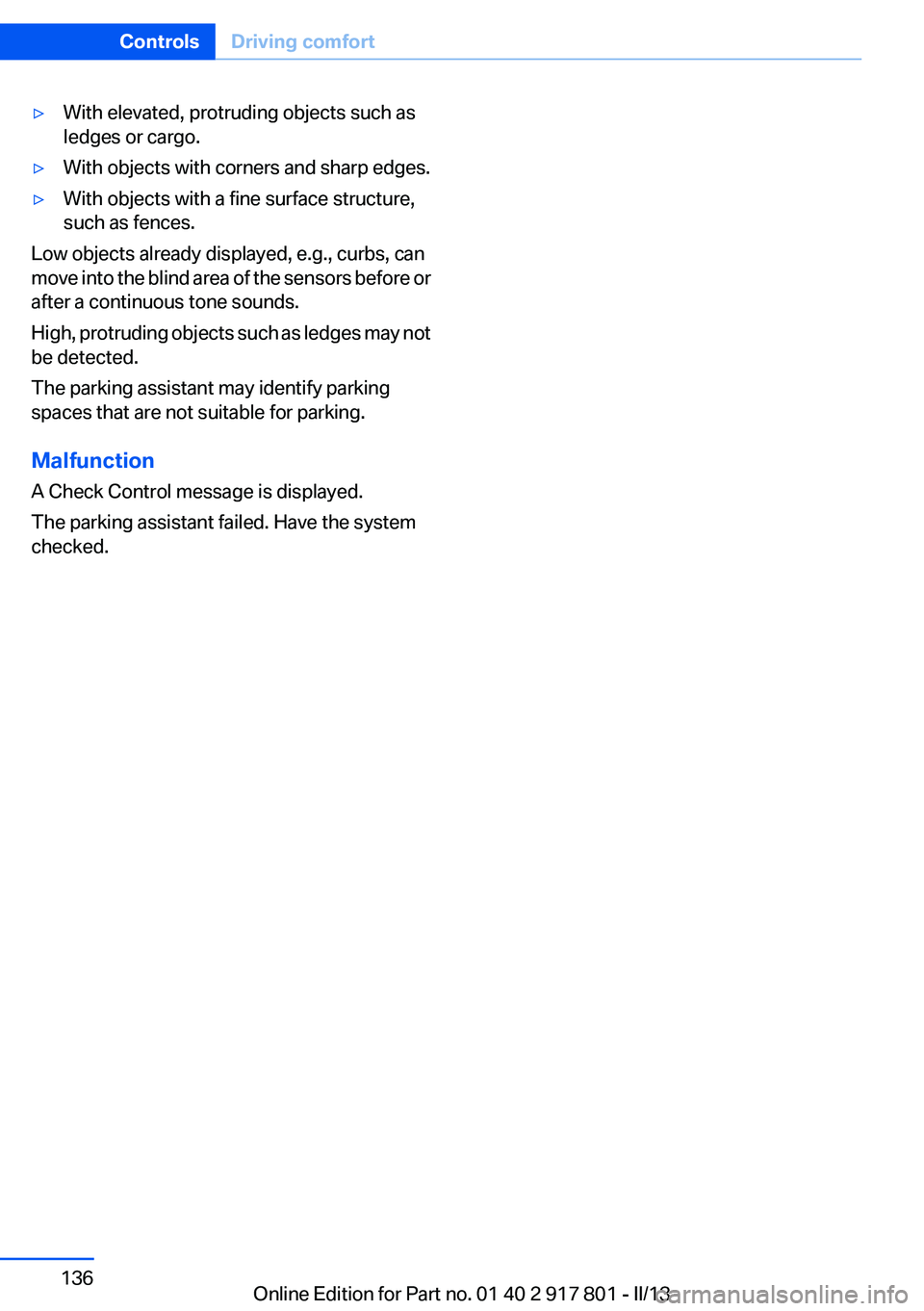
‚Ė∑With elevated, protruding objects such as
ledges or cargo.‚Ė∑With objects with corners and sharp edges.‚Ė∑With objects with a fine surface structure,
such as fences.
Low objects already displayed, e.g., curbs, can
move into the blind area of the sensors before or
after a continuous tone sounds.
High, protruding objects such as ledges may not
be detected.
The parking assistant may identify parking
spaces that are not suitable for parking.
Malfunction
A Check Control message is displayed.
The parking assistant failed. Have the system
checked.
Seite 136ControlsDriving comfort136
Online Edition for Part no. 01 40 2 917 801 - II/13
Page 137 of 242
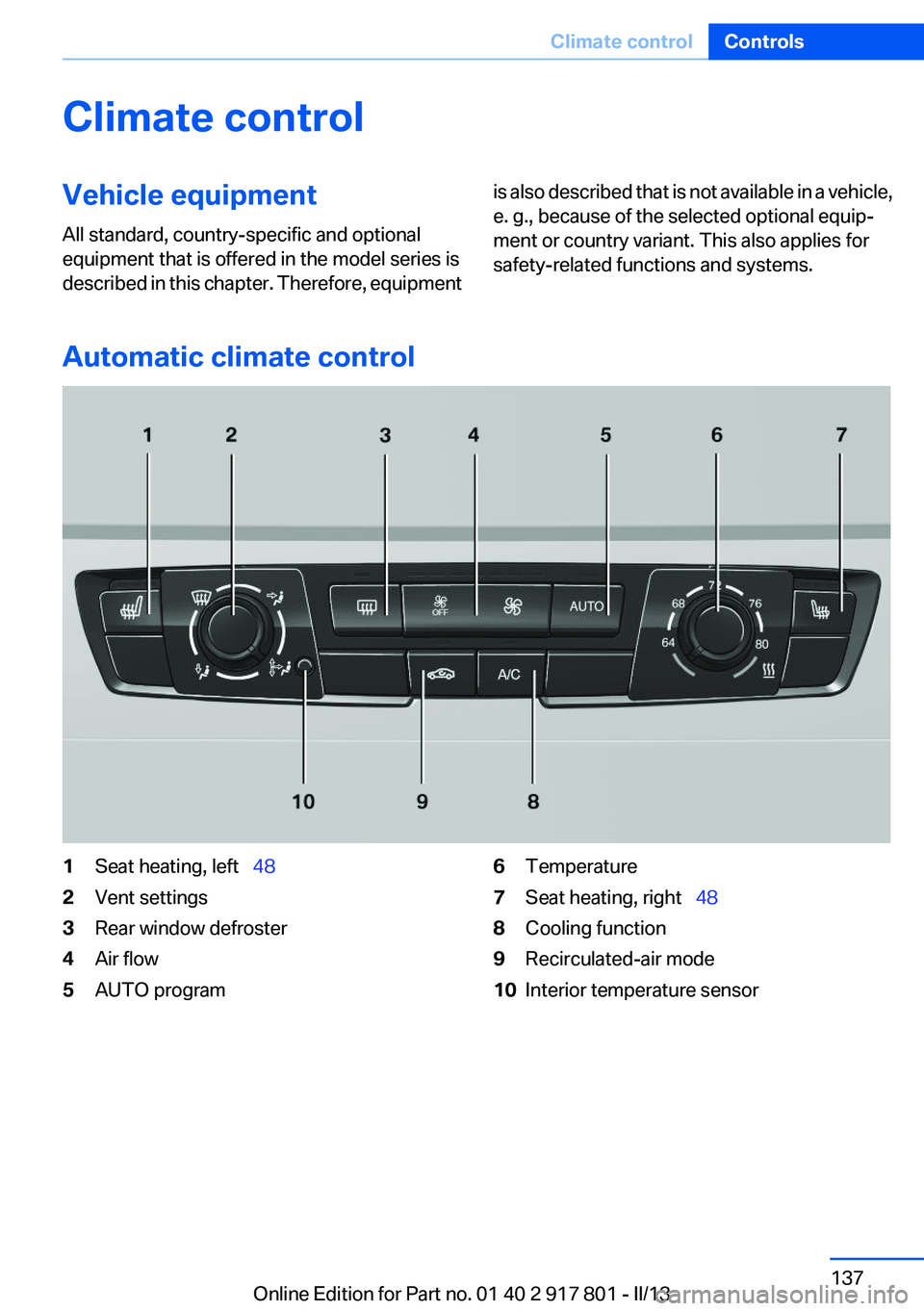
Climate controlVehicle equipment
All standard, country-specific and optional
equipment that is offered in the model series is
described in this chapter. Therefore, equipmentis also described that is not available in a vehicle,
e. g., because of the selected optional equip‚Äź
ment or country variant. This also applies for
safety-related functions and systems.
Automatic climate control
1Seat heating, left‚Äā‚ÄÖ 482Vent settings3Rear window defroster4Air flow5AUTO program6Temperature7Seat heating, right‚Äā‚ÄÖ 488Cooling function9Recirculated-air mode10Interior temperature sensorSeite 137Climate controlControls137
Online Edition for Part no. 01 40 2 917 801 - II/13
Page 140 of 242
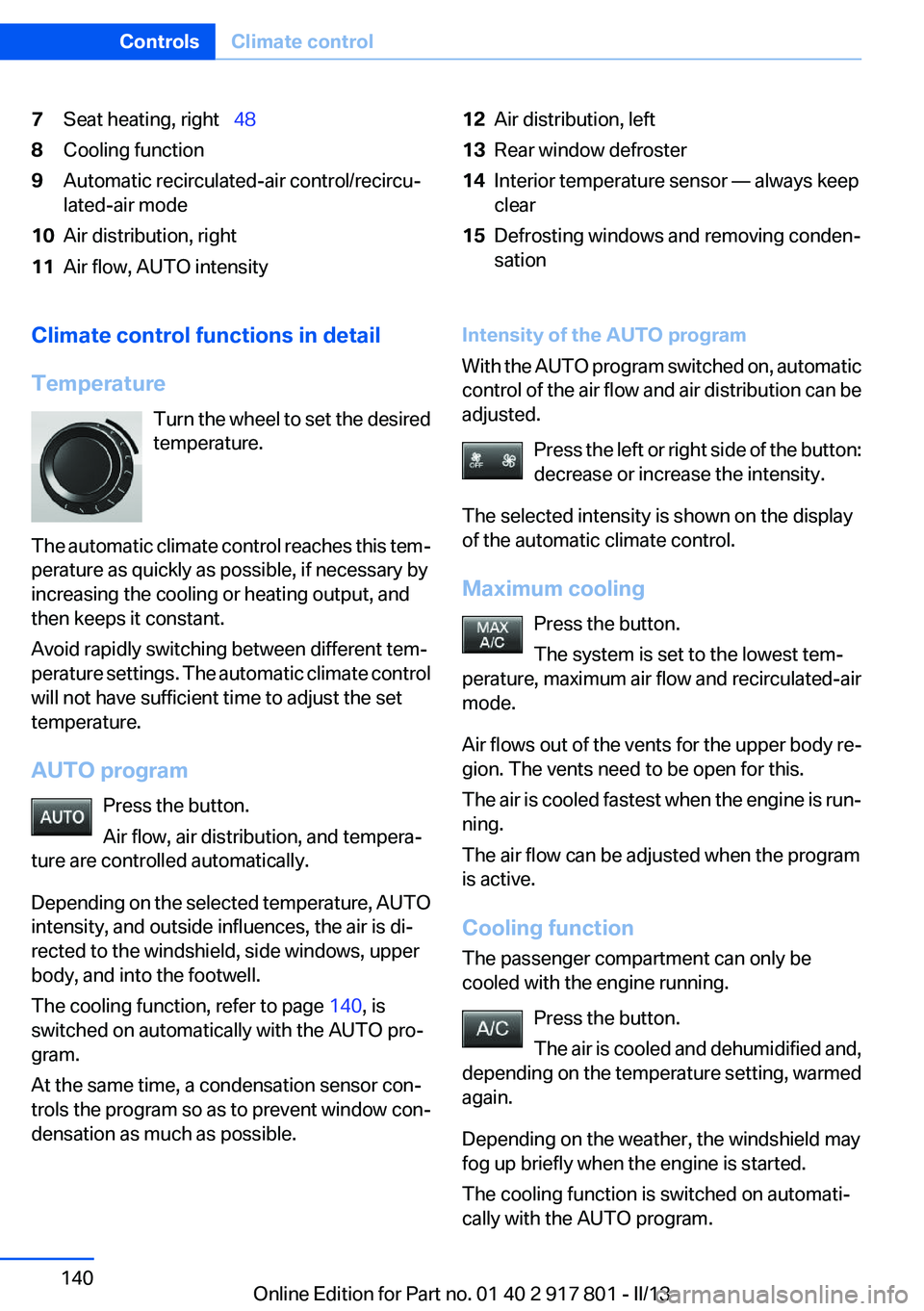
7Seat heating, right‚Äā‚ÄÖ488Cooling function9Automatic recirculated-air control/recircu‚Äź
lated-air mode10Air distribution, right11Air flow, AUTO intensity12Air distribution, left13Rear window defroster14Interior temperature sensor ‚ÄĒ always keep
clear15Defrosting windows and removing conden‚Äź
sationClimate control functions in detail
Temperature Turn the wheel to set the desired
temperature.
The automatic climate control reaches this tem‚Äź
perature as quickly as possible, if necessary by
increasing the cooling or heating output, and
then keeps it constant.
Avoid rapidly switching between different tem‚Äź
perature settings. The automatic climate control
will not have sufficient time to adjust the set
temperature.
AUTO program Press the button.
Air flow, air distribution, and tempera‚Äź
ture are controlled automatically.
Depending on the selected temperature, AUTO
intensity, and outside influences, the air is di‚Äź
rected to the windshield, side windows, upper
body, and into the footwell.
The cooling function, refer to page 140, is
switched on automatically with the AUTO pro‚Äź
gram.
At the same time, a condensation sensor con‚Äź
trols the program so as to prevent window con‚Äź
densation as much as possible.Intensity of the AUTO program
With the AUTO program switched on, automatic
control of the air flow and air distribution can be
adjusted.
Press the left or right side of the button:
decrease or increase the intensity.
The selected intensity is shown on the display
of the automatic climate control.
Maximum cooling Press the button.
The system is set to the lowest tem‚Äź
perature, maximum air flow and recirculated-air
mode.
Air flows out of the vents for the upper body re‚Äź
gion. The vents need to be open for this.
The air is cooled fastest when the engine is run‚Äź
ning.
The air flow can be adjusted when the program
is active.
Cooling function
The passenger compartment can only be
cooled with the engine running.
Press the button.
The air is cooled and dehumidified and,
depending on the temperature setting, warmed
again.
Depending on the weather, the windshield may
fog up briefly when the engine is started.
The cooling function is switched on automati‚Äź
cally with the AUTO program.Seite 140ControlsClimate control140
Online Edition for Part no. 01 40 2 917 801 - II/13
Page 141 of 242
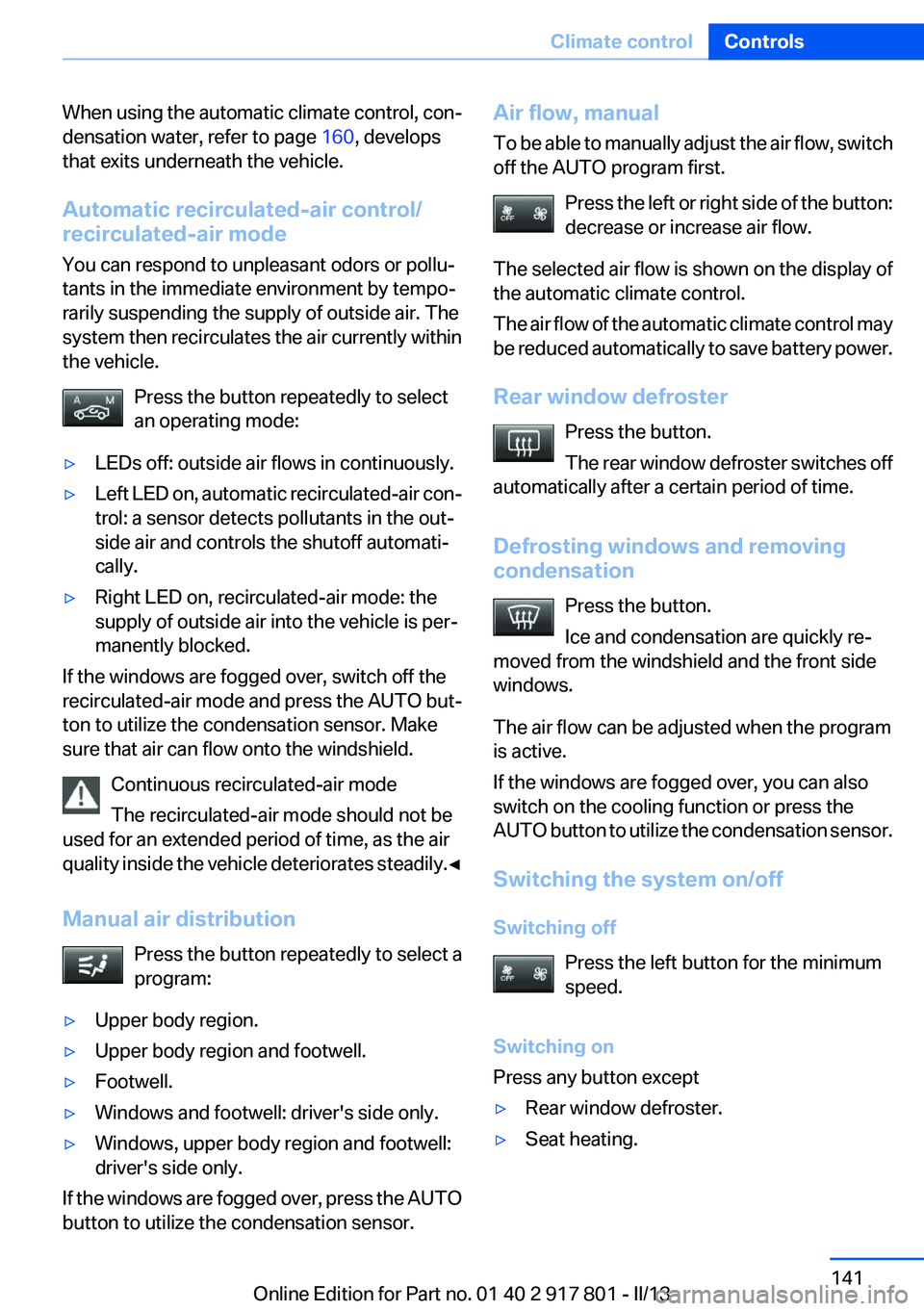
When using the automatic climate control, con‚Äź
densation water, refer to page 160, develops
that exits underneath the vehicle.
Automatic recirculated-air control/
recirculated-air mode
You can respond to unpleasant odors or pollu‚Äź
tants in the immediate environment by tempo‚Äź
rarily suspending the supply of outside air. The
system then recirculates the air currently within
the vehicle.
Press the button repeatedly to select
an operating mode:‚Ė∑LEDs off: outside air flows in continuously.‚Ė∑Left LED on, automatic recirculated-air con‚Äź
trol: a sensor detects pollutants in the out‚Äź
side air and controls the shutoff automati‚Äź
cally.‚Ė∑Right LED on, recirculated-air mode: the
supply of outside air into the vehicle is per‚Äź
manently blocked.
If the windows are fogged over, switch off the
recirculated-air mode and press the AUTO but‚Äź
ton to utilize the condensation sensor. Make
sure that air can flow onto the windshield.
Continuous recirculated-air mode
The recirculated-air mode should not be
used for an extended period of time, as the air
quality inside the vehicle deteriorates steadily. ‚óÄ
Manual air distribution Press the button repeatedly to select a
program:
‚Ė∑Upper body region.‚Ė∑Upper body region and footwell.‚Ė∑Footwell.‚Ė∑Windows and footwell: driver's side only.‚Ė∑Windows, upper body region and footwell:
driver's side only.
If the windows are fogged over, press the AUTO
button to utilize the condensation sensor.
Air flow, manual
To be able to manually adjust the air flow, switch
off the AUTO program first.
Press the left or right side of the button:
decrease or increase air flow.
The selected air flow is shown on the display of
the automatic climate control.
The air flow of the automatic climate control may
be reduced automatically to save battery power.
Rear window defroster Press the button.
The rear window defroster switches off
automatically after a certain period of time.
Defrosting windows and removing
condensation
Press the button.
Ice and condensation are quickly re‚Äź
moved from the windshield and the front side
windows.
The air flow can be adjusted when the program
is active.
If the windows are fogged over, you can also
switch on the cooling function or press the
AUTO button to utilize the condensation sensor.
Switching the system on/off
Switching off Press the left button for the minimum
speed.
Switching on
Press any button except‚Ė∑Rear window defroster.‚Ė∑Seat heating.Seite 141Climate controlControls141
Online Edition for Part no. 01 40 2 917 801 - II/13
Page 200 of 242
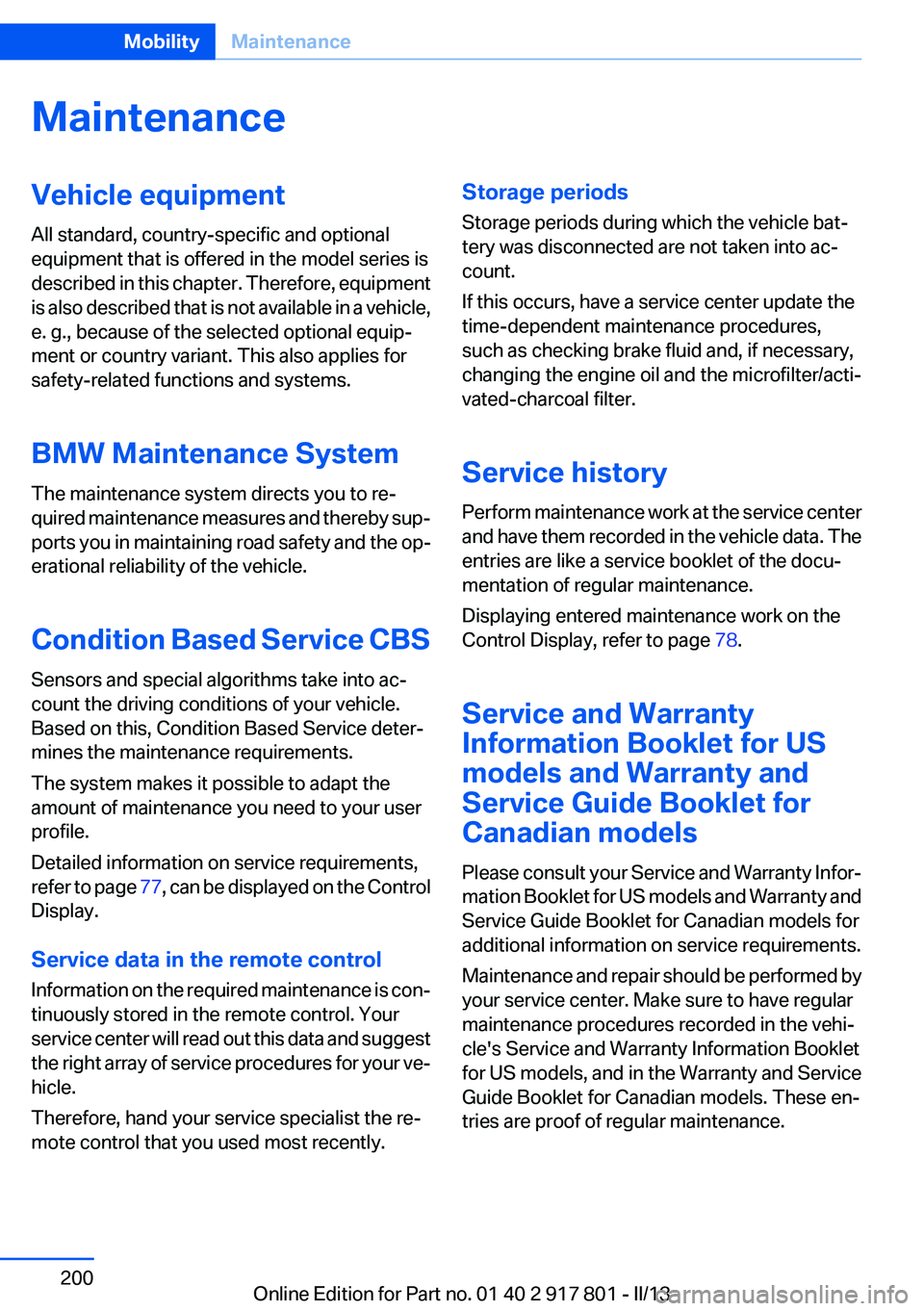
MaintenanceVehicle equipment
All standard, country-specific and optional
equipment that is offered in the model series is
described in this chapter. Therefore, equipment
is also described that is not available in a vehicle,
e. g., because of the selected optional equip‚Äź
ment or country variant. This also applies for
safety-related functions and systems.
BMW Maintenance System
The maintenance system directs you to re‚Äź
quired maintenance measures and thereby sup‚Äź
ports you in maintaining road safety and the op‚Äź
erational reliability of the vehicle.
Condition Based Service CBS
Sensors and special algorithms take into ac‚Äź
count the driving conditions of your vehicle.
Based on this, Condition Based Service deter‚Äź
mines the maintenance requirements.
The system makes it possible to adapt the
amount of maintenance you need to your user
profile.
Detailed information on service requirements,
refer to page 77, can be displayed on the Control
Display.
Service data in the remote control
Information on the required maintenance is con‚Äź
tinuously stored in the remote control. Your
service center will read out this data and suggest
the right array of service procedures for your ve‚Äź
hicle.
Therefore, hand your service specialist the re‚Äź
mote control that you used most recently.Storage periods
Storage periods during which the vehicle bat‚Äź
tery was disconnected are not taken into ac‚Äź
count.
If this occurs, have a service center update the
time-dependent maintenance procedures,
such as checking brake fluid and, if necessary,
changing the engine oil and the microfilter/acti‚Äź
vated-charcoal filter.
Service history
Perform maintenance work at the service center
and have them recorded in the vehicle data. The
entries are like a service booklet of the docu‚Äź
mentation of regular maintenance.
Displaying entered maintenance work on the
Control Display, refer to page 78.
Service and Warranty
Information Booklet for US
models and Warranty and
Service Guide Booklet for
Canadian models
Please consult your Service and Warranty Infor‚Äź
mation Booklet for US models and Warranty and
Service Guide Booklet for Canadian models for
additional information on service requirements.
Maintenance and repair should be performed by
your service center. Make sure to have regular
maintenance procedures recorded in the vehi‚Äź
cle's Service and Warranty Information Booklet
for US models, and in the Warranty and Service
Guide Booklet for Canadian models. These en‚Äź
tries are proof of regular maintenance.Seite 200MobilityMaintenance200
Online Edition for Part no. 01 40 2 917 801 - II/13
Page 219 of 242
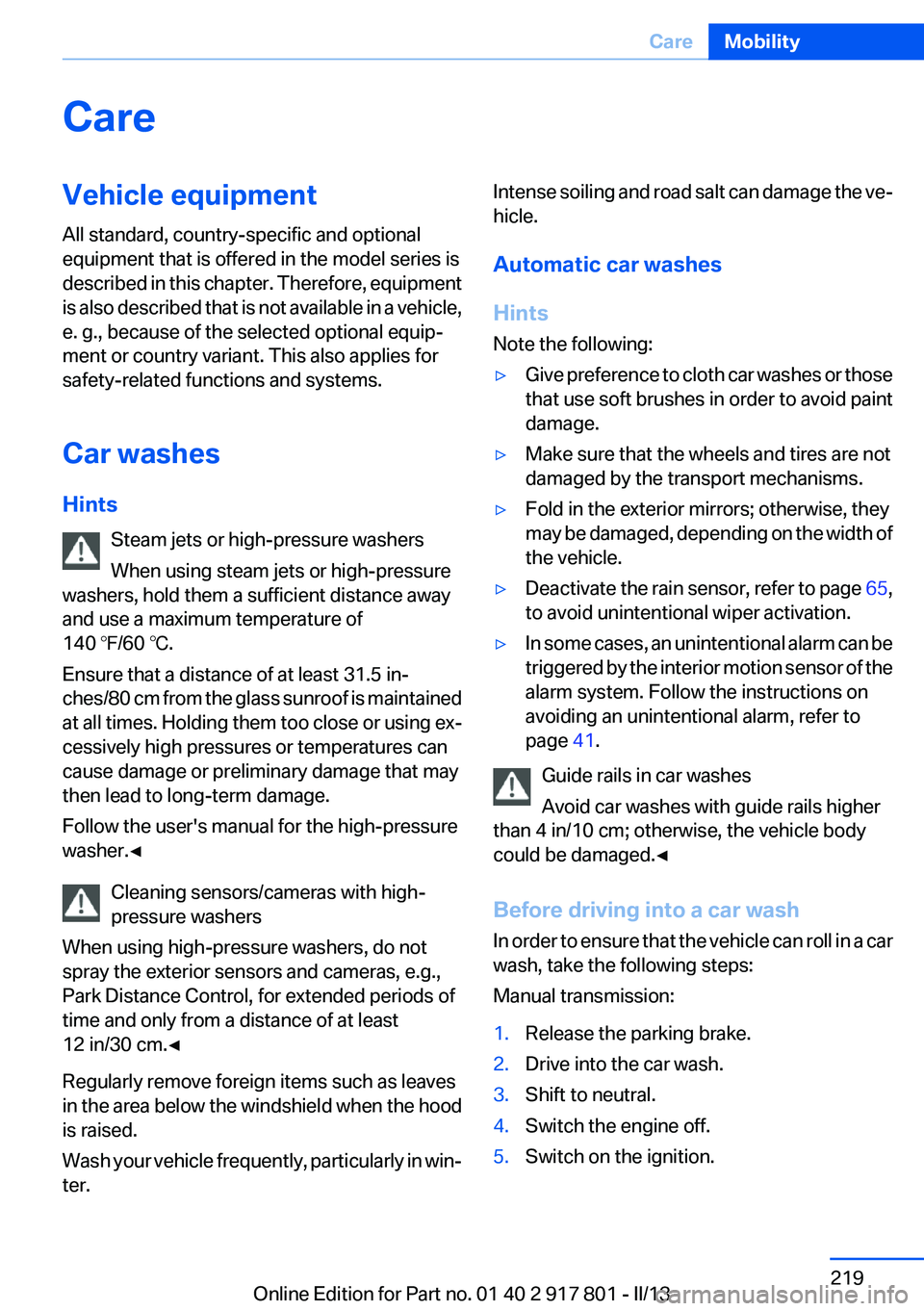
CareVehicle equipment
All standard, country-specific and optional
equipment that is offered in the model series is
described in this chapter. Therefore, equipment
is also described that is not available in a vehicle,
e. g., because of the selected optional equip‚Äź
ment or country variant. This also applies for
safety-related functions and systems.
Car washes
Hints Steam jets or high-pressure washers
When using steam jets or high-pressure
washers, hold them a sufficient distance away
and use a maximum temperature of
140 ‚ĄČ/60 ‚ĄÉ.
Ensure that a distance of at least 31.5 in‚Äź
ches/80 cm from the glass sunroof is maintained
at all times. Holding them too close or using ex‚Äź
cessively high pressures or temperatures can
cause damage or preliminary damage that may
then lead to long-term damage.
Follow the user's manual for the high-pressure
washer.‚óÄ
Cleaning sensors/cameras with high-
pressure washers
When using high-pressure washers, do not
spray the exterior sensors and cameras, e.g.,
Park Distance Control, for extended periods of
time and only from a distance of at least
12 in/30 cm.‚óÄ
Regularly remove foreign items such as leaves
in the area below the windshield when the hood
is raised.
Wash your vehicle frequently, particularly in win‚Äź
ter.Intense soiling and road salt can damage the ve‚Äź
hicle.
Automatic car washes
Hints
Note the following:‚Ė∑Give preference to cloth car washes or those
that use soft brushes in order to avoid paint
damage.‚Ė∑Make sure that the wheels and tires are not
damaged by the transport mechanisms.‚Ė∑Fold in the exterior mirrors; otherwise, they
may be damaged, depending on the width of
the vehicle.‚Ė∑Deactivate the rain sensor, refer to page 65,
to avoid unintentional wiper activation.‚Ė∑In some cases, an unintentional alarm can be
triggered by the interior motion sensor of the
alarm system. Follow the instructions on
avoiding an unintentional alarm, refer to
page 41.
Guide rails in car washes
Avoid car washes with guide rails higher
than 4 in/10 cm; otherwise, the vehicle body
could be damaged.‚óÄ
Before driving into a car wash
In order to ensure that the vehicle can roll in a car
wash, take the following steps:
Manual transmission:
1.Release the parking brake.2.Drive into the car wash.3.Shift to neutral.4.Switch the engine off.5.Switch on the ignition.Seite 219CareMobility219
Online Edition for Part no. 01 40 2 917 801 - II/13
Page 222 of 242
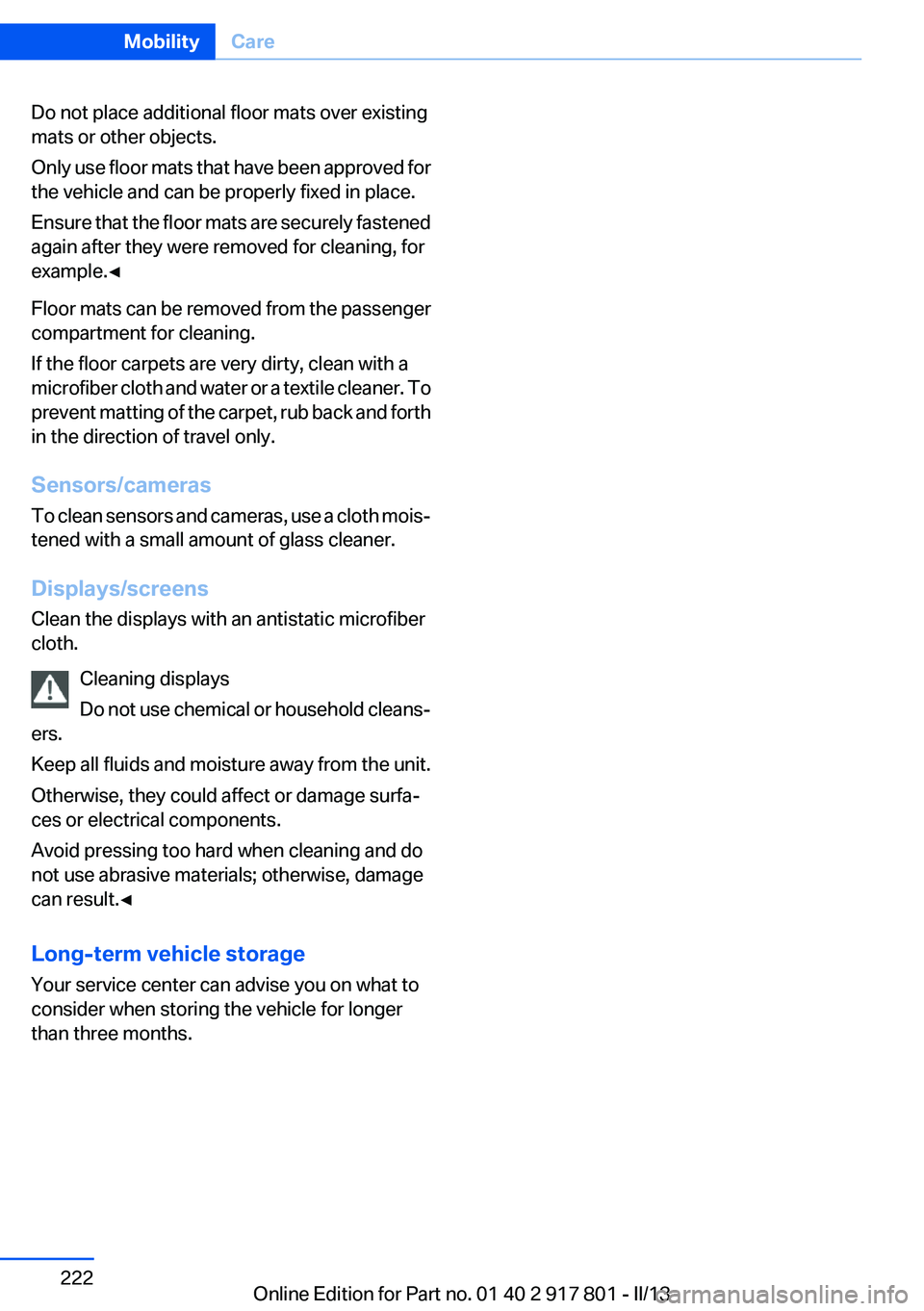
Do not place additional floor mats over existing
mats or other objects.
Only use floor mats that have been approved for
the vehicle and can be properly fixed in place.
Ensure that the floor mats are securely fastened
again after they were removed for cleaning, for
example.‚óÄ
Floor mats can be removed from the passenger
compartment for cleaning.
If the floor carpets are very dirty, clean with a
microfiber cloth and water or a textile cleaner. To
prevent matting of the carpet, rub back and forth
in the direction of travel only.
Sensors/cameras
To clean sensors and cameras, use a cloth mois‚Äź
tened with a small amount of glass cleaner.
Displays/screens
Clean the displays with an antistatic microfiber
cloth.
Cleaning displays
Do not use chemical or household cleans‚Äź
ers.
Keep all fluids and moisture away from the unit.
Otherwise, they could affect or damage surfa‚Äź
ces or electrical components.
Avoid pressing too hard when cleaning and do
not use abrasive materials; otherwise, damage
can result.‚óÄ
Long-term vehicle storage
Your service center can advise you on what to
consider when storing the vehicle for longer
than three months.Seite 222MobilityCare222
Online Edition for Part no. 01 40 2 917 801 - II/13